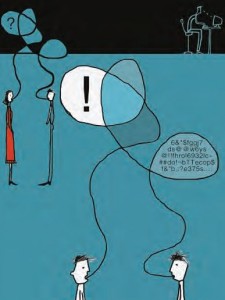Monday, 7:30 AM: I sit at my office desk on a lovely Vermont morning, preparing for my workday, head down, focused, planning web edits, help text, and user guide additions when the phone rings, startling me.
“I need a favor,” the voice begins, without preamble, dangling that last word. Urgency fills the air, then “Dude! A big favor.”
 It’s Sallie, the trainer I had been contracted to work with over the past year. I smile. We are friends. Sallie travels a lot and time together, even a phone call, is precious.
It’s Sallie, the trainer I had been contracted to work with over the past year. I smile. We are friends. Sallie travels a lot and time together, even a phone call, is precious.
“Sallie, I thought you were in California?” I ask.
“I am.” I’m perplexed a bit by this, but quickly gather the situation.
“You are? What is it, 4:30 AM there? You’re not at the client’s site working? Are you?” I fire these questions off in rapid succession.
“Yes. To all of that.” There’s a pause. “That’s why I need the big favor.”
The favor was simple to explain but certainly not simple to complete.
The Project. Before going to California, Sallie was creating new course descriptions and customizing existing ones for a new client. That was the favor: could I complete this project for him?
I had recently created some of these course descriptions myself, so I understood the content. What I didn’t know, at least at this point, was that Sallie had barely begun. The course descriptions Sallie had already outlined needed to be changed; all the new course descriptions still needed to be created. In other words, I was starting from scratch.
I created almost five dozen course descriptions, compiling them into a course catalog, designed with a standard letter-size format. The catalog was distributed in both a printed version and an electronic PDF.
To create the course catalog, I used a process that, for the sake of a label, I call traditional technical communication. I worked on this project over five years ago. Today, in the burgeoning world of social media, that same project might proceed quite differently, employing a process that, again for the sake of a label, I call social media technical communication. I explain—and contrast—both processes below.
Why compare and contrast these two methods? Many reasons, actually: to demonstrate how social media is changing the way we communicate, to engage our audience in a dialogue, to create a sense of community, and to better meet expectations.
Traditional Technical Communication. I knew the drill on how to proceed within the specified guidelines, and the skill set I needed to tap for this project: interview, write, design.
First, I interviewed. I met with the project manager to define the scope of the project. The project manager, while understanding the software’s major features, was certainly not a technical expert, being more in tune with marketing and sales. From that meeting, I learned two things. First, the new client had purchased the basic software package with a number of add-on features; I needed to create a course description encompassing all of these features. Second, the client needed to train over 200 employees, all of whom would be taking multiple courses.
I next met with numerous subject matter experts (juggling their schedules with mine) to discover the features of the various add-on packages—how these features worked and how they were used to get work accomplished.
Next, I wrote. I created a list of the courses that needed to be offered (58 in all), and I defined the context for each course description. The list included many existing course descriptions, all of which needed to be customized, as well as about three dozen new courses. Since there were so many courses being offered, I decided to create a numbering scheme, somewhat like college course offerings. I used round numbers in the hundreds for major add-on features and tens level for each area within the add-on (such as 210, 220, and 230).
 Each course had a number enabling the client to see a clear progression of areas and topics. Each course description contained a title, a list of topics presented, objectives, audience, maximum class size, skill level, prerequisites, and contact hours (this last one being important because it related directly to billed hours). Subject matter experts provided technical comments. Without an editor, I had to edit and proofread the materials myself.
Each course had a number enabling the client to see a clear progression of areas and topics. Each course description contained a title, a list of topics presented, objectives, audience, maximum class size, skill level, prerequisites, and contact hours (this last one being important because it related directly to billed hours). Subject matter experts provided technical comments. Without an editor, I had to edit and proofread the materials myself.
Finally, I designed a course catalog. I used some existing corporate sales materials as a basis for my design, included the corporate logo, tagline, and corporate font. The catalog had a cover page, copyright information, a table of contents, and the course descriptions (each cleanly presented on one page). As a final deliverable, I printed and created a PDF of the catalog for the project manager.
Not once during this entire project did I speak with the client or any personnel who were to be trained. I created the course catalog entirely based on information from the project manager and the subject matter experts. The project manager delivered the completed course catalog to the client, fielded comments from the project administrators (not from managers whose staff would be trained, nor from any member of this staff), and reported these comments back to me. I was completely hidden behind the corporate veil, left alone to write in peace.
The bottom line: I created, they used; it was a fairly standard one-to-many communication.
I worked on all of this in 2003. Looking back, the process was lovely—in an introverted and myopic sort of way. Still, the course catalog I created got the job done and, after a few minor tweaks, was ultimately accepted by the client.
Social Media Technical Communication. With the advent of Web 2.0 in the last couple of years and its myriad social media, that same project today would proceed much differently (given an enlightened corporation, I suppose). While I would still tap into my core technical communication skills—interviewing, writing, and designing—the creation and implementation of the course catalog would follow a decidedly different path and it would be better because of it. If I were to take on this catalog in today’s social media world, I would be:
- The expert, providing content for collaboration (not simple consumption).
- On the front line, visible for all to see—the extrovert (not hidden and anonymous).
- An enabler (or moderator if you will) soliciting, interacting, and gathering comments and reactions from engaged users in short, fluid cycles (not disengaged, unknown users).
So how might this work in a social media world? Consider this process:
I would still start out by interviewing the project manager and the subject matter experts, but I would also interview the client project administrators, their front-line managers, and certain expert and novice users (essentially, my audience). What I would gain is invaluable insight into how the client intended to use the software to get work done, who the users are and what they need to learn to perform their jobs, what the basic challenges of the managers are, and how this client defines a successful training program.
Next, I would write the course descriptions based on all this information, knowing first-hand the client’s goals in order to better meet their expectations. I would still create the course numbering system and the categories to describe each course, but rather than that being the final word, I would engage the client to determine the value of this information and the related content.
Finally, I would desi gn the course catalog, eliciting commentary from my audience about the overall design and usability. When completed, I would post the catalog to a site that users could interact with (securely, of course), with a link for downloading a PDF.
gn the course catalog, eliciting commentary from my audience about the overall design and usability. When completed, I would post the catalog to a site that users could interact with (securely, of course), with a link for downloading a PDF.
The bottom line: the creation of the catalog in a social media world would be a collaborative effort, combining the knowledge of all participants, or a many-to- many communication.
Implementing a Social Media Dialogue. Social media is all about creating community by engaging people through interactions and conversations around a shared goal. For this project, the shared goal is clear: creating courses that effectively train users to efficiently do their jobs. I could implement this community in a number of ways.
- A blog creates an opportunity for all users to comment on whatever is posted, whether it’s the course content, the description, the process, the training plan, or whatever else affects the shared goal. I could use a blog to present discussion topics about the entire process (an 8,000 meter view).
- A forum is another great way to create dialogue. A forum can maintain a number of different threads on various topics, with the community able to quickly read past comments and post their thoughts.
- On a wiki, I might post course descriptions, with the community rewriting them. Wikis must be carefully managed to capture the collective knowledge of the community.
- A mini social network could capture the essence of the community members and their backgrounds and expertise, all in an effort to bring everyone together.
I would moderate all of these social media interactions, and I would be responsible for managing, collecting, evaluating, and including the most relevant comments and feedback. This is where my expertise as a technical communicator would most come into play.
In a different vein, I would also be responsible for setting the tone of the conversation, which could prove to be formidable, given the right set of circumstances. This is where my social skills would be most valuable, as well as my position as the expert.
The Bottom Line. Imagine yourself working for this client: Management has just chosen a new software package that you must know how to use in order to get your job done. Picture the meeting where you are told that you must attend a series of half-day and full-day training courses; it is an imposed decision.
Now envision this meeting in the social media setting. Together with your community of colleagues, you are participating in a series of half-day and full-day training courses that you all helped create. Wouldn’t that work better?
In a social media setting, the skill set of the technical communicator grows. The ability to successfully apply these skills, however, becomes more transparent. Ultimately, though, while the line of authorship blurs, content would become richer, deeper, more useful, and would include multiple ownership or collaboration. A collaboration through social media, properly undertaken, results in the truest form of audience-centered content.
And isn’t that what technical communication is all about?
—Rich Maggiani
[Note: This post is an article originally published in the March 2009 issue of Intercom, the magazine of the Society for Technical Communication (STC).]